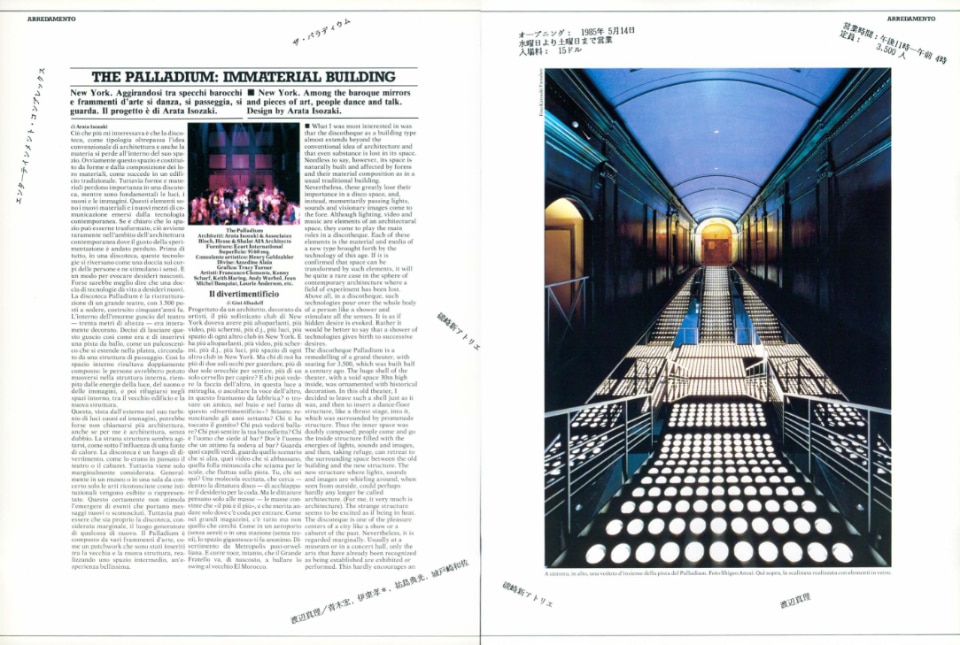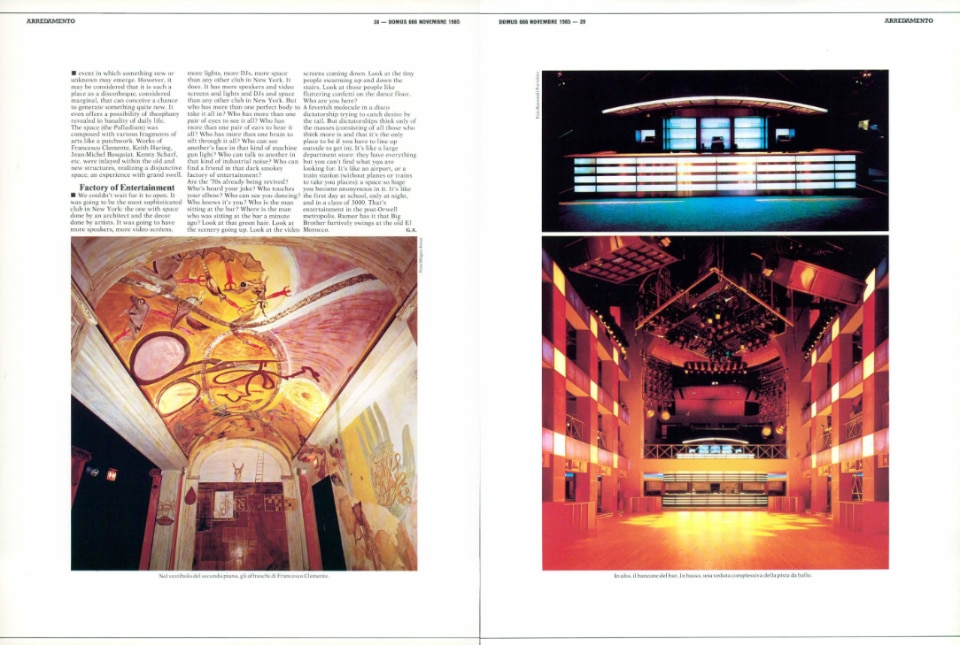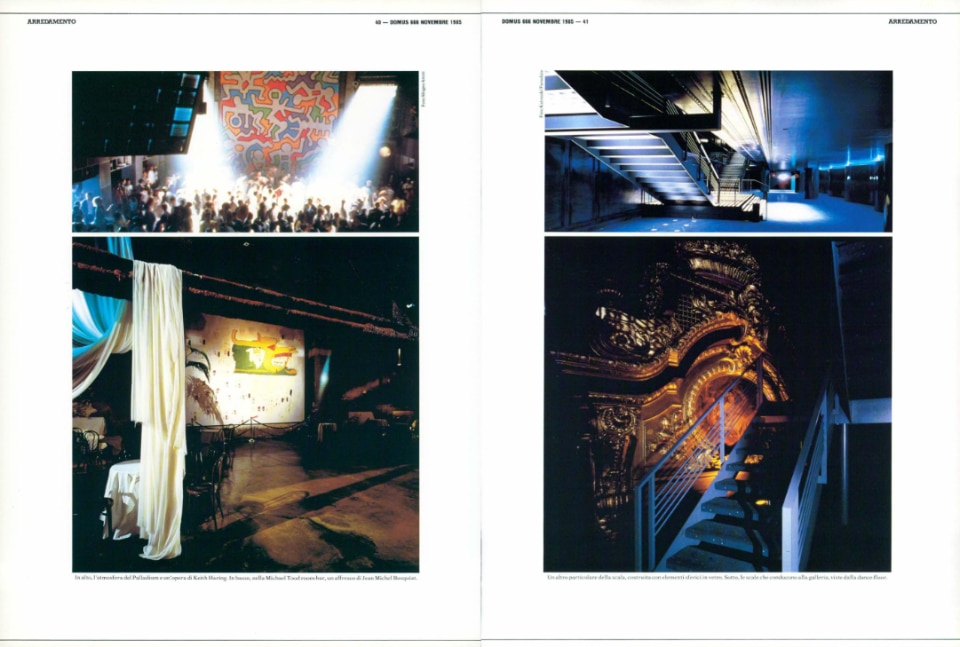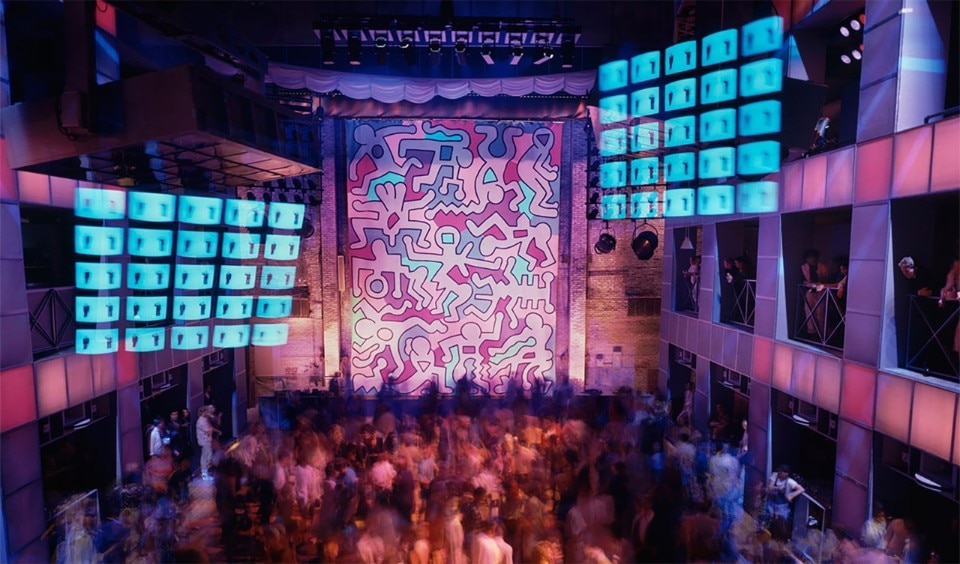It took less than three years, from 1977 to 1980, to not only turn the world’s clubbing imaginaire upside down but to unleash a totalizing revolution in aesthetic and social visions. Those were the disco years, the three years we mentioned were the whole lifespan of Studio 54 in New York (but it will not be alone, between Paradise Garage and other iconic clubs). Once these years were over, the Studio closed, founders Steve Rubell and Ian Schrager went through a fair amount of trouble with the law, and by the mid-1980s they were ready to write another chapter of cultural history: but everything has changed, New York had changed, society with its desires had changed. Postmodern, consumerist times had come, and so the time had come for the Palladium. Arata Isozaki at the spaces, transavantgarde and street art on the walls, with Basquiat, Haring and Clemente creating real frescoes. It would last until 1998, to be replaced by a NYU student residence. Domus, however, would present the club immediately upon its opening, in November 1985, on issue 666.

The Palladium: immaterial Building
What I was most interested in was that the discotheque as a building type almost extends beyond the conventional idea of architecture and that even substance is lost in its space. Needless to say, however, its space is naturally built and affected by forms and their material composition as in a usual traditional building.
Nevertheless, these greatly lose their importance in a disco space, and, instead, momentarily passing lights, sounds and visionary images come to the fore. Although lighting, video and music are elements of an architectural space, they come to play the main roles in a discotheque. Each of these elements is the material and media of a new type brought forth by the technology of this age. If it is confirmed that space can be transformed by such elements, it will be quite a rare case in the sphere of contemporary architecture where a field of experiment has been lost. Above all, in a discotheque, such technologies pour over the whole body of a person like a shower and stimulate all the senses. It is as if hidden desire is evoked. Rather it would be better to say that a shower of technologies gives birth to successive desires.

The discotheque Palladium is a remodelling of a grand theater, with seating for 3,500, which was built half a century ago. The huge shell of the theater, with a void space 30m high inside, was ornamented with historical decoration. In this old theater, I decided to leave such a shell just as it was, and then to insert a dance-floor structure, like a thrust stage, into it, which was surrounded by promenade structure. Thus the inner space was doubly composed; people come and go the inside structure filled with the energies of lights, sounds and images, and then, taking refuge, can retreat to the surrounding space between the old building and the new structure.
Ma le dittature pensano solo alle masse, le masse convinte che ‘il più è il più’, e che merita andare solo dove c'è coda per entrare.
The new structure where lights, sounds and images are whirling around, when seen from outside, could perhaps hardly any longer be called architecture. (For me, it very much is architecture). The strange structure seems to be excited as if being in heat. The discoteque is one of the pleasure centers of a city like a show or a cabaret of the past. Nevertheless, it is regarded marginally. Usually at a museum or in a concert hall, only the arts that have already been recognized as being established are exhibited or performed. This hardly encourages an event in which something new or unknown may emerge.
However, it may be considered that it is such a place as a discotheque, considered marginal, that can conceive a chance to generate something quite new. It even offers a possibility of theophany revealed in banality of daily life. The space (the Palladium) was composed with various fragments of arts like a patchwork. Works of Francesco Clemente, Keith Haring, Jean-Michel Basquiat, Kenny Scharf, etc. were inlayed within the old and new structures, realizing a disjunctive space, an experience with grand swell.
Arata Isozaki

Factory of Entertainment
We couldn’t wait for it to open. It was going to be the most sophisticated club in New York: the one with space done by an architect and the decor done by artists. It was going to have more speakers, more video screens, more lights, more DJs, more space than any other club in New York. It does. It has more speakers and video screens and lights and DJs and space than any other club in New York. But who has more than one perfect body to take it all in? Who has more than one pair of eyes to see it all? Who has more than one pair of ears to hear it all? Who has more than one brain to sift through it all? Who can see another’s face in that kind of machine gun light? Who can talk to another in that kind of industrial noise? Who can find a friend in that dark smokey factory of entertainment? Are the ‘70s already being revived? Who’s heard your joke? Who touches your elbow? Who can see you dancing? Who knows it’s you? Who is the man sitting at the bar? Where is the man who was sitting at the bar a minute ago? Look at that green hair. Look at the scenery going up. Look at the video screens coming down. Look at the tiny people swarming up and down the stairs. Look at those people like fluttering confetti on the dance floor. Who are you here? A feverish molecule in a disco dictatorship trying to catch desire by the tail. But dictatorships think only of the masses (consisting of all those who think more is and that it’s the only place to be if you have to line up outside to get in). It’s like a large department store: they have everything but you can’t find what you are looking for. It's like an airport, or a train station (without planes or trains to take you places): a space so huge you become anonymous in it. It's like the first day at school, only at night, and in a class of 3000. That’s entertainment in the post-Orwell metropolis. Rumor has it that Big Brother furtively swings at the old El Morocco.
Gini Alhadeff
Opening image: Mural by Keith Haring in the Palladium, New York, 1985. Photo by Timothy Hursley, Garvey Simon Gallery


